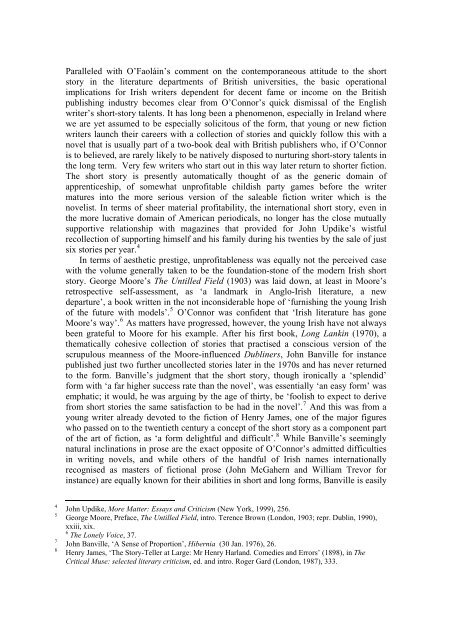Inside Out: A Working Theory of the Irish Short Story. John Kenny
Inside Out: A Working Theory of the Irish Short Story. John Kenny
Inside Out: A Working Theory of the Irish Short Story. John Kenny
You also want an ePaper? Increase the reach of your titles
YUMPU automatically turns print PDFs into web optimized ePapers that Google loves.
Paralleled with O’Faoláin’s comment on <strong>the</strong> contemporaneous attitude to <strong>the</strong> short<br />
story in <strong>the</strong> literature departments <strong>of</strong> British universities, <strong>the</strong> basic operational<br />
implications for <strong>Irish</strong> writers dependent for decent fame or income on <strong>the</strong> British<br />
publishing industry becomes clear from O’Connor’s quick dismissal <strong>of</strong> <strong>the</strong> English<br />
writer’s short-story talents. It has long been a phenomenon, especially in Ireland where<br />
we are yet assumed to be especially solicitous <strong>of</strong> <strong>the</strong> form, that young or new fiction<br />
writers launch <strong>the</strong>ir careers with a collection <strong>of</strong> stories and quickly follow this with a<br />
novel that is usually part <strong>of</strong> a two-book deal with British publishers who, if O’Connor<br />
is to believed, are rarely likely to be natively disposed to nurturing short-story talents in<br />
<strong>the</strong> long term. Very few writers who start out in this way later return to shorter fiction.<br />
The short story is presently automatically thought <strong>of</strong> as <strong>the</strong> generic domain <strong>of</strong><br />
apprenticeship, <strong>of</strong> somewhat unpr<strong>of</strong>itable childish party games before <strong>the</strong> writer<br />
matures into <strong>the</strong> more serious version <strong>of</strong> <strong>the</strong> saleable fiction writer which is <strong>the</strong><br />
novelist. In terms <strong>of</strong> sheer material pr<strong>of</strong>itability, <strong>the</strong> international short story, even in<br />
<strong>the</strong> more lucrative domain <strong>of</strong> American periodicals, no longer has <strong>the</strong> close mutually<br />
supportive relationship with magazines that provided for <strong>John</strong> Updike’s wistful<br />
recollection <strong>of</strong> supporting himself and his family during his twenties by <strong>the</strong> sale <strong>of</strong> just<br />
six stories per year. 4<br />
In terms <strong>of</strong> aes<strong>the</strong>tic prestige, unpr<strong>of</strong>itableness was equally not <strong>the</strong> perceived case<br />
with <strong>the</strong> volume generally taken to be <strong>the</strong> foundation-stone <strong>of</strong> <strong>the</strong> modern <strong>Irish</strong> short<br />
story. George Moore’s The Untilled Field (1903) was laid down, at least in Moore’s<br />
retrospective self-assessment, as ‘a landmark in Anglo-<strong>Irish</strong> literature, a new<br />
departure’, a book written in <strong>the</strong> not inconsiderable hope <strong>of</strong> ‘furnishing <strong>the</strong> young <strong>Irish</strong><br />
<strong>of</strong> <strong>the</strong> future with models’. 5 O’Connor was confident that ‘<strong>Irish</strong> literature has gone<br />
Moore’s way’. 6 As matters have progressed, however, <strong>the</strong> young <strong>Irish</strong> have not always<br />
been grateful to Moore for his example. After his first book, Long Lankin (1970), a<br />
<strong>the</strong>matically cohesive collection <strong>of</strong> stories that practised a conscious version <strong>of</strong> <strong>the</strong><br />
scrupulous meanness <strong>of</strong> <strong>the</strong> Moore-influenced Dubliners, <strong>John</strong> Banville for instance<br />
published just two fur<strong>the</strong>r uncollected stories later in <strong>the</strong> 1970s and has never returned<br />
to <strong>the</strong> form. Banville’s judgment that <strong>the</strong> short story, though ironically a ‘splendid’<br />
form with ‘a far higher success rate than <strong>the</strong> novel’, was essentially ‘an easy form’ was<br />
emphatic; it would, he was arguing by <strong>the</strong> age <strong>of</strong> thirty, be ‘foolish to expect to derive<br />
from short stories <strong>the</strong> same satisfaction to be had in <strong>the</strong> novel’. 7 And this was from a<br />
young writer already devoted to <strong>the</strong> fiction <strong>of</strong> Henry James, one <strong>of</strong> <strong>the</strong> major figures<br />
who passed on to <strong>the</strong> twentieth century a concept <strong>of</strong> <strong>the</strong> short story as a component part<br />
<strong>of</strong> <strong>the</strong> art <strong>of</strong> fiction, as ‘a form delightful and difficult’. 8 While Banville’s seemingly<br />
natural inclinations in prose are <strong>the</strong> exact opposite <strong>of</strong> O’Connor’s admitted difficulties<br />
in writing novels, and while o<strong>the</strong>rs <strong>of</strong> <strong>the</strong> handful <strong>of</strong> <strong>Irish</strong> names internationally<br />
recognised as masters <strong>of</strong> fictional prose (<strong>John</strong> McGahern and William Trevor for<br />
instance) are equally known for <strong>the</strong>ir abilities in short and long forms, Banville is easily<br />
4<br />
<strong>John</strong> Updike, More Matter: Essays and Criticism (New York, 1999), 256.<br />
5<br />
George Moore, Preface, The Untilled Field, intro. Terence Brown (London, 1903; repr. Dublin, 1990),<br />
xxiii, xix.<br />
6<br />
The Lonely Voice, 37.<br />
7<br />
<strong>John</strong> Banville, ‘A Sense <strong>of</strong> Proportion’, Hibernia (30 Jan. 1976), 26.<br />
8<br />
Henry James, ‘The <strong>Story</strong>-Teller at Large: Mr Henry Harland. Comedies and Errors’ (1898), in The<br />
Critical Muse: selected literary criticism, ed. and intro. Roger Gard (London, 1987), 333.

















